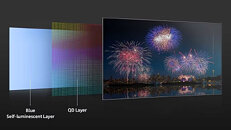TheLostSwede
News Editor
- Joined
- Nov 11, 2004
- Messages
- 18,062 (2.44/day)
- Location
- Sweden
| System Name | Overlord Mk MLI |
|---|---|
| Processor | AMD Ryzen 7 7800X3D |
| Motherboard | Gigabyte X670E Aorus Master |
| Cooling | Noctua NH-D15 SE with offsets |
| Memory | 32GB Team T-Create Expert DDR5 6000 MHz @ CL30-34-34-68 |
| Video Card(s) | Gainward GeForce RTX 4080 Phantom GS |
| Storage | 1TB Solidigm P44 Pro, 2 TB Corsair MP600 Pro, 2TB Kingston KC3000 |
| Display(s) | Acer XV272K LVbmiipruzx 4K@160Hz |
| Case | Fractal Design Torrent Compact |
| Audio Device(s) | Corsair Virtuoso SE |
| Power Supply | be quiet! Pure Power 12 M 850 W |
| Mouse | Logitech G502 Lightspeed |
| Keyboard | Corsair K70 Max |
| Software | Windows 10 Pro |
| Benchmark Scores | https://valid.x86.fr/yfsd9w |
Welcome to the battle of the Korean OLED display makers, where LG Display is now claiming that Samsung's new-ish QD OLED displays are far more susceptible to screen burn, compared to its own WOLED displays. In a way, this is LG getting back at Samsung, as the latter has criticised LG for quite some time, over screen burn on its OLED displays, despite the fact that Samsung hasn't had any of its own OLED products until last year. LG Display is basing much of its claims on testing by Rtings, which isn't yet publicly available, but the company also has a technical explanation behind it all.
Both LG's and Samsung's OLED panels are based around RGB subpixels, just like most LCD panels, with the difference being that OLED panels don't have a backlight, as the pixels themselves are supposed to emit the light. However, RGB subpixels on larger screens tend to lack in brightness and this is why LG added white subpixels to its WOLED panels, which was also a source of criticism from Samsung. However, Samsung's QD OLED displays use a blue OLED layer behind a Quantum Dot layer, which is meant to produce a brighter image than LG's WOLED panels. LG now claims that because Samsung went down the path of using pure RGB subpixels, each subpixel is subjected to a lot more stress on static images than its own WOLED design, which in turn causes screen burn. LG Display did apparently not go into much more details than that at the online press conference the company had called last week, so we'll have to wait and see what Rtings reveals in its next update on its long term testing, which is supposed to take place sometime this month.
Update Mar 3rd 15:08 UTC: Rtings reached out to us and explained that they didn't provide any data to LG Display. Instead, LG Display based its assumptions on photos posted by Rtings on its website. Rtings provided the following statement:

View at TechPowerUp Main Site | Source
Both LG's and Samsung's OLED panels are based around RGB subpixels, just like most LCD panels, with the difference being that OLED panels don't have a backlight, as the pixels themselves are supposed to emit the light. However, RGB subpixels on larger screens tend to lack in brightness and this is why LG added white subpixels to its WOLED panels, which was also a source of criticism from Samsung. However, Samsung's QD OLED displays use a blue OLED layer behind a Quantum Dot layer, which is meant to produce a brighter image than LG's WOLED panels. LG now claims that because Samsung went down the path of using pure RGB subpixels, each subpixel is subjected to a lot more stress on static images than its own WOLED design, which in turn causes screen burn. LG Display did apparently not go into much more details than that at the online press conference the company had called last week, so we'll have to wait and see what Rtings reveals in its next update on its long term testing, which is supposed to take place sometime this month.
Update Mar 3rd 15:08 UTC: Rtings reached out to us and explained that they didn't provide any data to LG Display. Instead, LG Display based its assumptions on photos posted by Rtings on its website. Rtings provided the following statement:
We didn't send any information to LG Display. We published our two-month data and pictures in two waves on February 6th and 16th. It appears LG took these images from our reviews when they were released publicly.
Further to that point, LG Display also did not reach out to us prior to their press call where they referenced our test and images.

View at TechPowerUp Main Site | Source






